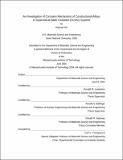| dc.contributor.advisor | Ronald M. Latanision and Ronald G. Ballinger. | en_US |
| dc.contributor.author | Kim, Hojong, 1974- | en_US |
| dc.contributor.other | Massachusetts Institute of Technology. Dept. of Materials Science and Engineering. | en_US |
| dc.date.accessioned | 2005-05-17T14:45:07Z | |
| dc.date.available | 2005-05-17T14:45:07Z | |
| dc.date.copyright | 2004 | en_US |
| dc.date.issued | 2004 | en_US |
| dc.identifier.uri | http://hdl.handle.net/1721.1/16636 | |
| dc.description | Thesis (Ph. D.)--Massachusetts Institute of Technology, Dept. of Materials Science and Engineering, 2004. | en_US |
| dc.description | Includes bibliographical references (leaves 179-186). | en_US |
| dc.description | This electronic version was submitted by the student author. The certified thesis is available in the Institute Archives and Special Collections. | en_US |
| dc.description.abstract | Supercritical water oxidation (SCWO) is a technology that can effectively destroy aqueous organic waste above the critical point of pure water. These waste feed streams are very aggressive and pose material performance issues. As potential alloys in construction of SCWO systems, nickel-base alloys are tested. Corrosion in aqueous feed streams of ambient pH values of 2, 1 and 7 is studied both at supercritical (-425⁰C) and subcritical (-300-360⁰C) temperatures with a constant pressure of 24.1MPa. Dealloying of Ni and Fe, and oxidation of Cr and Mo are observed at subcritical temperatures at a pH value of 2. At a pH value of 1, even chromium is selectively dissolved and only molybdenum forms a stable oxide at the subcritical temperature. At supercritical temperatures, normal thin oxidation occurs at both pH values of pH 2 and 7. In contrast, in the neutral pH solution, dealloying is not observed at any temperature. Stress corrosion cracking (SCC) in acidic feed streams is observed both at the supercritical and subcritical temperatures. In order to understand the corrosion mechanisms, the chemistry of a feed stream, the formation of the dealloyed oxide layer, and the level of stress are investigated. | en_US |
| dc.description.abstract | (cont.) The suppression of dealloying at supercritical temperatures comes from the low proton concentration associated with the low dissociation constant of HCl and water. However, the growth rate of the dealloyed oxide layer at subcritical temperatures is very fast, which is primarily due to the dealloying and the high diffusivity of the nickel in this defective oxide layer. SCC at subcritical temperatures results from the dealloyed oxide layer formation along the grain boundary as intrusions, which act as a precursor to the crack initiation and propagation. SCC at the supercritical temperature is thought to result from the direct chemical attack of associated HC1 molecules. SCC is not observed in the neutral solution. | en_US |
| dc.description.statementofresponsibility | by Hojong Kim. | en_US |
| dc.format.extent | 186 leaves | en_US |
| dc.format.extent | 13676939 bytes | |
| dc.format.extent | 14760905 bytes | |
| dc.format.mimetype | application/pdf | |
| dc.format.mimetype | application/pdf | |
| dc.language.iso | eng | en_US |
| dc.publisher | Massachusetts Institute of Technology | en_US |
| dc.rights | M.I.T. theses are protected by copyright. They may be viewed from this source for any purpose, but reproduction or distribution in any format is prohibited without written permission. See provided URL for inquiries about permission. | en_US |
| dc.rights.uri | http://dspace.mit.edu/handle/1721.1/7582 | |
| dc.subject | Materials Science and Engineering. | en_US |
| dc.title | An investigation of corrosion mechanisms of constructional alloys in supercritical water oxidation (SCWO) systems | en_US |
| dc.type | Thesis | en_US |
| dc.description.degree | Ph.D. | en_US |
| dc.contributor.department | Massachusetts Institute of Technology. Department of Materials Science and Engineering | |
| dc.identifier.oclc | 56028573 | en_US |
